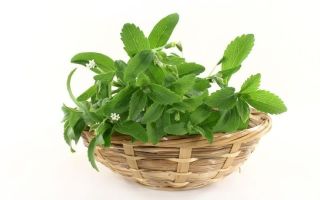Content
- 1 What is stevia and where does it grow
- 2 Composition and calorie content of stevia
- 3 Benefits of stevia
- 4 Slimming stevia
- 5 Benefits and harms of stevia for diabetes
- 6 Stevia during pregnancy and breastfeeding
- 7 Can Stevia be given to children
- 8 Forms of release of stevia
- 9 How to take stevia
- 10 Stevia recipes
- 11 The use of stevia in cosmetology
- 12 Harm of stevia and contraindications
- 13 Which is better: stevia, fructose, or sucralose
- 14 Conclusion
- 15 Reviews
Among the many sweeteners, stevia is perhaps the leader in terms of a whole range of beneficial properties. She was even given the proud title of 21st century herb. However, due to the fact that there were controversies in the scientific community around the addition of a plant to food, the train of negative opinion still affects the reputation of the herb and leaves questions: what really is the benefits and harms of stevia for the human body.
What is stevia and where does it grow

Stevia (Stevia Rebaudiana), or honey grass, is a subtropical perennial shrub with 2 - 3 cm leaves and miniature white flowers, which was originally found in the southern and central parts of the American continent. Paraguay, Mexico and Brazil are traditionally considered the birthplace of the honey herb stevia, but it has spread all over the world, including in southern Russia.
The origin of the herb is mysterious: according to one of the versions, the involvement in the discovery of the beneficial properties of the plant is attributed to the botanist and doctor Stevius, who lived in the 16th century, and according to the other, Stevia owes its name to the famous Russian scientist Steven.
And the name "honey herb" was assigned to stevia from the Guarani Indians, who appreciated its properties both as a sweetener and as a medicine.
And the source of the unique sweetness of the honey herb - glycosides - were identified by French researchers in 1931. Later, in the 70s of the XX century, its properties of a sugar substitute for the manufacture of drinks were adopted in the food industry in Japan, at the same time herbal teas based on it gained great popularity. Honey grass is widely used in culinary experiments in the United States as an additive to recipes for desserts, baked goods, and dairy products.
Composition and calorie content of stevia

Stevia has a sweet taste thanks to its glycosides, mainly stevizoid, which includes glucose, sophorose and steviol, which give the herb a unique sweetness. Stevisoid is obtained from herb extract and is used in the food industry as an additive labeled E960, which is classified as safe.
The complex of glycosides in the herb is also supplemented with:
- rebaudiosides A, C, B;
- dulcoside;
- rubuzoside.
Stevia also boasts a wealth of beneficial ingredients:
- vitamins A, E, K, C, P (rutin), PP (nicotinic acid) and group B;
- essential oils;
- fiber;
- minerals: potassium, phosphorus, zinc, magnesium, calcium, selenium, iron and silicon.
The sweet properties of stevia exceed beet sugar 25 times, with negligible calories:
One hundred grams of grass contains 18 kcal, which is especially appreciated in dietary nutrition.
Benefits of stevia

In addition to the benefits of using instead of sugar, stevia has a whole list of valuable properties:
- Stevisoids have the inherent quality of nourishing the pancreas and restoring its functions.
- In small doses, the beneficial effect of stevia on lowering blood pressure was noted, and in large doses - on a slight increase. This indicates the importance of dosing the intake of the herb and the need for its individual prescription by a specialist.
- Taking the herb in small doses slightly increases the heart rate, and in large doses it slightly slows down.
- Stevia is able to inhibit the development of pathogenic bacteria and microorganisms. So, taking the herb with tea serves as a useful prophylaxis against caries and periodontal disease, which is harmful to tooth loss, and in particular, in diseases of diabetes mellitus. These properties work in special organic medicated toothpastes that include stevia leaves. And honey herb tinctures are beneficial in the treatment of colds and flu.
- A separate point of application of the bactericidal properties of the herb is the wound healing effect. Stevia is also used in the treatment of burns, poisonous insect bites, dermatitis and even eczema.
- The benefits for the human body of external use of stevia are not inferior to the effect of its use inside: in the composition of lotions and masks, the herb improves skin condition, eliminates dermatitis and even eczema.
- A food supplement from stevia helps to improve digestion in a complex way, acting simultaneously on the kidneys and on the liver.
- The use of honey herb reduces the harm of tobacco and alcohol dependence.
The abundance of useful properties makes the plant a real healer for a number of diseases:
- hypotension;
- diabetes mellitus;
- hypertension;
- dermatitis;
- periodontal disease;
- seborrhea and eczema.
You can learn more about the benefits and harms of stevia from the video:
Slimming stevia
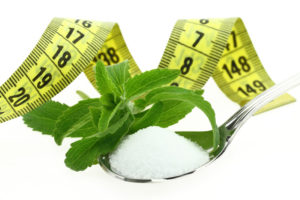
Stevia glycosides, with their zero calorie content, surpass sucrose in their beneficial properties, which has found application in weight loss diets.
The easiest option is to include stevisoid E960 in the diet and use it to sweeten dishes. You can buy it in specialized stores or pharmacies.
You can also use an unsynthesized version - an infusion of dry stevia herb,
Preparation:
For 200 ml of water, take 20 g of chopped grass, mix, bring to a boil, cook for 5 minutes. and insist for another 10 minutes. After that, the composition is poured into a heated thermos and insisted in it for 12 hours. After that, filter the liquid into a sterilized glass container. The rest of the grass is poured with 100 ml of boiling water and insisted for another 8 hours. The infusion is added to the previously prepared one, mixed by shaking.
Added to drinks and meals.
The third option for using stevia for weight loss is herbal tea in bags or chalk dry leaves in bulk. The drink will benefit when taken 2 times a day half an hour before meals.
For cooking, use 1 filter bag or 1 tsp. chopped herbs in a glass of water brought to a boil. Insist for 10 minutes.
In tablets, stevia is taken up to 3 times a day, half an hour before meals, 1 - 2 pieces, washed down with warm boiled water or dissolved in a small amount of pure water. The maximum allowable dose is 6 tablets per day.
Benefits and harms of stevia for diabetes
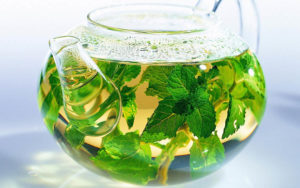
The beneficial property of stevia to help lower blood sugar levels is used in diabetes.
In the insulin-dependent form (type 1), the herb is taken as an additional prophylactic agent, while type 2 diabetes does not imply dependence on insulin, therefore stevia benefits directly from inclusion in the diabetic menu or as a prophylaxis.
Stevia uses for diabetes:
- Infusion - brewed according to a standard recipe, as for weight loss;
- Liquid extract, which must be taken 1 tsp. with food or drinks;
- Tablets - take up to 3 times a day according to the instructions.
In addition, the benefits for diabetics can be manifested in the bactericidal properties of stevia, which help to heal wounds and trophic ulcers with a diabetic foot without scarring: in this case, shallow wounds are moistened with a herb concentrate.
A quick version of the infusion is prepared as follows:
Chopped honey grass - 2 tbsp. l. placed in a bag of 2 layers of gauze, poured with boiling water (1 tbsp.) and kept on low heat for up to half an hour. Then it is poured into a bottle. The contents of the gauze bag are re-poured with half a glass of water, also insisted for half an hour, mixed with the first broth. The resulting infusion is additionally filtered.
Stevia during pregnancy and breastfeeding
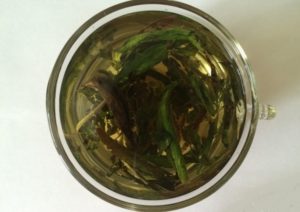
The benefits and harms of stevia as a sweetener during pregnancy and lactation are controversial. On the one hand, the use of a healthy honey herb is undoubtedly able to normalize the digestive tract, improve metabolism, help the heart and blood vessels, and enhance immunity.
On the other hand, during this period, the body is especially sensitive to various food agents and is able to show an increased reaction, including to herbal remedies.
Therefore, the decision to use stevia in the menu should be strictly in accordance with the doctor's advice.
During lactation, you can be less afraid of using stevia supplements, but it is important to conduct a test within 24 hours for the ability of herbal components to cause harm to an allergic reaction.
In the absence of general indications and a negative result of an allergy test, you can carefully add the herb to food, while controlling your well-being.
The plant will also be useful in restoring weight after childbirth, strengthening the body as a whole.
Can Stevia be given to children
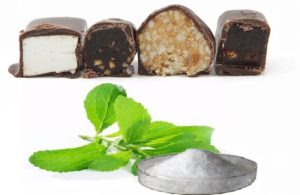
Considering that children love sweets, the properties of stevia as a natural organic sugar substitute will help a child's diet, especially in cases of contraindications to the use of sugar-containing products. The herb extract, which is devoid of flavor, is an excellent solution to such problems.
Stevia tea can also be used to help prevent viral diseases and boost immunity.
Forms of release of stevia
Stevia is available on the market today in a variety of convenient forms:
- effervescent tablets in dispenser packages;
- crystalline powder, resembling sugar;
- liquid syrup;
- elixir;
- standardized extract;
- in the form of dry crushed grass;
- dry finely ground leaves in filter bags.
For those who like to grow plants, you can have stevia on the windowsill - the benefits of freshly brewed leaves will exceed the use of the drug in tablets.
How to take stevia
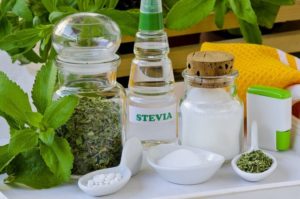
With a healthy state of the body, there are no dosage restrictions in taking the supplement.
Powdered stevia is usually packaged in sachets of 1 and 2 g. It should be diluted in water, focusing on the proportion of 1 g per 1 tbsp. warm water.
The sweetener in tablets has the properties of slowly dissolving, so it will take a little time when stirring with a spoon.
Stevia syrup is added at the rate of 4 drops per glass of liquid product or, according to taste, to solid foods: this is not only convenient, but also beneficial, unlike adding sugar.
Stevia recipes
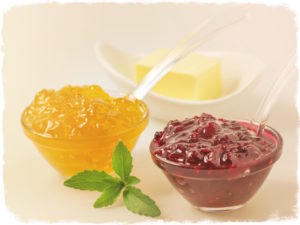
In cooking, stevia is used with the benefit of a natural sweetener, sweetening drinks and dishes, homemade cakes, sweets, cold desserts with it.
The benefits of stevia as a natural preservative are used in the preparation of products, while the herb is able to neutralize the harm of fungi and microorganisms.
It is important to know some of the features of its preparation:
- Before using stevia in baking, you should first test its taste: it is specific for the plant, somewhat reminiscent of licorice, therefore it is not suitable for everyone. It is worth pre-brewing tea and only then decide whether the herb is suitable as a spice in dishes.
Important! Stevia extract - stevisoid - is unflavored, so it can be of great benefit to those who don't like the herb.
- There are tricks to kill the taste of honey grass: for this, you can put cinnamon, lemon zest in the dish. It is best to use stevia powder in baked goods (rather than chopped leaves). And you can add leaves to cookies and desserts - to taste. Stevia tea can be diluted with other herbs: chamomile, rose hips, Sudanese rose, citrus fruits.
- If crushed stevia is indicated in the ingredients of the recipe, then we are talking specifically about grinding a dry plant. Usually you need more than the herbal concentrate in powder.
Stevia tea
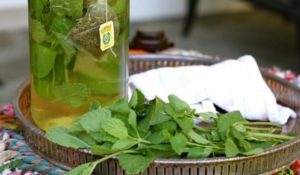
The easiest way to make stevia tea is to use teabags, which are available from your supermarket, specialty store, or pharmacy. The bags are poured not with boiling water, but with water brought to a temperature of 90 aboutS: this way the benefits of stevia will be better revealed.
The color of freshly brewed tea is brown, while tea that has been brewed for several hours is dark green.
You can prepare stevia for tea yourself if the plant is grown in a summer cottage. The most suitable time for collection will be the flowering time, when the stevisoid is most concentrated in the grass. The leaves are cut. Dry and grind into powder.
Cooking method.
1 tablespoon of chopped stevia herb is poured with 1 liter brought to 90 aboutFrom the water. Cover and leave for 20 minutes. To prepare the tea leaves, take half a liter of water.
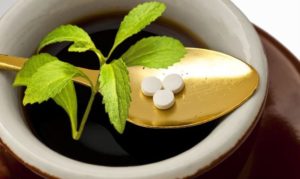
Another option for making tea as a sweetener in drinks instead of sugar is to boil the stevia herb for 15 minutes and then infuse in a thermos for 10 hours. To do this, take 1 glass of water for 1 tablespoon of stevia "with a slide".
The beneficial properties of stevia herb tea are that it:
- strengthens the body, normalizes immunity, blood circulation, blood glucose and blood pressure;
- helps in scarring stomach ulcers, improves the functioning of the intestines, liver and kidneys;
- eliminates gastritis and caries.
Stevia tincture
For its preparation, fresh or dry stevia herb is poured with alcohol (you can use vodka) so as to completely cover the dry raw material. Then they insist for a day and filter.
On the basis of such an alcoholic extract, a syrup is subsequently prepared.
Stevia syrup
The benefits of stevia syrup in drinks and desserts will be irreplaceable.
To prepare it, pour green leaves and shoots with water and boil for 40 minutes. Next, the liquid is filtered and evaporation is continued over low heat or a water bath until the consistency is when the drop will not spread on the plate.
A syrup can be prepared from an alcoholic or water-based herb extract. The liquid is also evaporated for 4 - 6 hours, making sure that it does not boil until the syrup begins to flow smoothly in the form of a thin stream on the spoon. The finished syrup is poured into a bottle and stored for up to 1.5 years, at room temperature - the beneficial properties of stevia will be preserved.
Stevia cookies
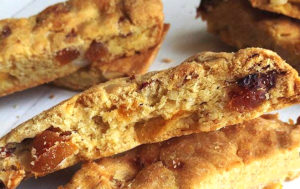
For the Stevia Oatmeal Christmas Cookie you will need:
- oatmeal - 200 g;
- fat-free cottage cheese - 200 g;
- eggs - 2 pcs.;
- dried cranberries (cherries) - 100 g;
- raisins - 50 g;
- whole grain flour - 50 g;
- cognac - 25 g;
- stevisoid - 10 tablets or 1 tsp;
- zest of 1 orange.
Cooking sequence:
- Soak cranberries or cherries with raisins in warm water, drain and rinse.
- Mixed rolled oats, flour with baking powder.
- Beat the eggs lightly, add to the dough and then add cottage cheese, berries, zest in turn. Cognac is added.
- All are mixed and spread on parchment.
- Bake for 25 minutes. in the oven at 200 ° C.
Compote
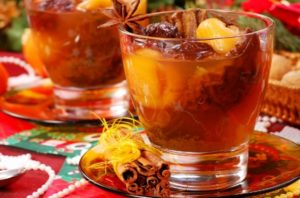
Christmas compote with stevia
Ingredients:
- water - 1.5 l;
- quince, apples - 6 pcs.;
- orange - 1 pc.;
- cinnamon - 1 stick;
- cardamom - 3 - 4 seeds;
- star anise - 3 stars;
- stevia - 1 filter bag;
- rose hips - 1 sachet.
Cooking steps:
- Apples and quince are cut into cubes.
- The zest is removed from the orange, and the slices are cleaned of grain and cut into 3 parts each.
- Bring water to a boil, lay apples, quince and boil a little.
- Add orange to the boiling mixture.
- When the fruit is cooked (determined by softness), spices are added: orange zest, cinnamon, crushed cardamom and star anise.
- Bring the fruit to full readiness, add a bag of stevia and rose hips, cover and remove from heat.
The output of the finished product is 2 liters.
The use of stevia in cosmetology
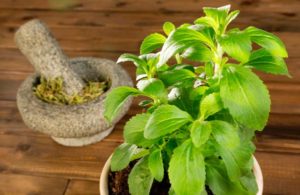
The beneficial properties of stevia to improve the condition of the skin and hair have been appreciated by women who use the herb in home cosmetics.
Dry honey herb crushed to powder, diluted with warm water to make a gruel, is used with benefit and for the preparation of masks that increase the smoothness and elasticity of the skin: both independently for nutrition, and with other ingredients.
Mask for dry skin
Gruel of chopped grass is mixed with olive oil - 1 tsp each. each component, add raw yolk and beat thoroughly with a fork. Apply to face until the mask dries. Remove carefully: the dried composition with protein can harm the skin.
Mask for oily skin
A mixture of a teaspoon of stevia gruel is mixed with raw protein and 1 tsp. lemon juice.
The herb also has beneficial properties as a decoction for hair.
Rinses with stevia for hair.
Stevia leaves, dry and fresh - 2 tbsp. l. - pour a glass of boiling water and insist for 3 hours. For rinsing, mix 1 glass of broth with 1 liter of purified or mineral water.
The use of such a procedure every time after shampooing will be useful for activating hair growth, increasing its density, and imparting shine.
Harm of stevia and contraindications
The ambiguous attitude towards grass in official research has given rise to a myth about its dangers. So, published in 1985, scientific data made public conclusions about the carcinogenic properties of stevia, which produced a scandal effect. And only additional experiments in 2006 rehabilitated the plant in the reports of the World Health Organization: as a natural product, stevia is recognized as a useful supplement that has no restrictions, contraindications and side effects in use.
However, they are still present in synthetic and herbal medicines. Restrictions concern:
- individual intolerance to the product;
- pregnancy and lactation - ambiguous recommendations: should be treated with caution and with mandatory consultation with a doctor;
- under 12 years of age;
- gastroenteritis.
Which is better: stevia, fructose, or sucralose

Comparing the benefits and harms of popular sweeteners that replace sugar fructose and sucralose in relation to stevia, it is possible to draw conclusions about individual preferences for a particular drug.
So, sucralose is characterized by:
- obtaining from sugar in a concentration that enhances its sweet properties by 600 times;
- when the glycemic index is equal to zero (meaning no effect on blood sugar levels);
- the substance is able to retain its properties after heat treatment;
- do not give an unpleasant aftertaste;
- removed from the body per day.
Its disadvantages include a restriction in dosage in the amount of 5 mg per kilogram of weight, exceeding which can threaten the extra pounds.
As for fructose, its features are:
- synthetic origin (by hydrolysis during the breakdown of sucrose);
- exceeding the sweet properties of sugar by about 1.5 times, pleasant taste;
- low glycemic index;
- the ability to enhance the taste of fruit.
Conditional disadvantages can be denoted a high calorie content of the product, limiting the daily intake to 40 g, the excess of which preserves the risks of obesity.
With all the listed advantages and disadvantages of various sugar substitutes, in this respect, the undoubted advantage of the stevia herb in terms of medicinal properties can be noted.
Conclusion
The heated debate about the benefits and harms of stevia subsided in connection with the WHO recognition of the harmlessness of the herb for humans. Now we can confidently say about stevia as a gift from nature, a natural medicine given to people to maintain health, and with it - beauty and youth.

